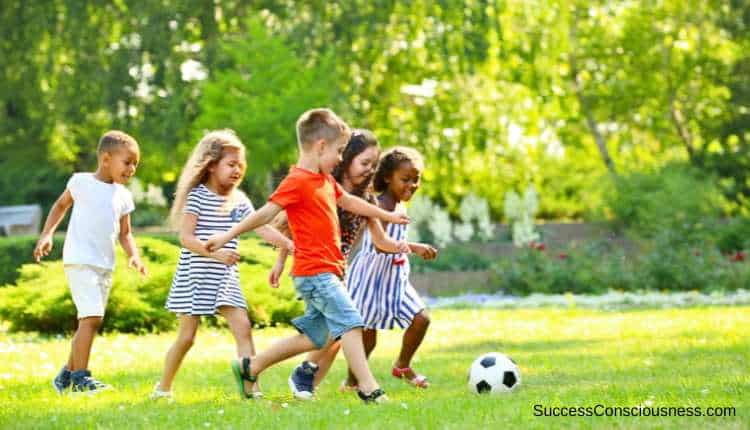
When thinking about a school, it’s easy to picture students grouped by grade level. However, this concept is relatively new. For centuries, children of varying ages learned and played together.
While modern education has largely adopted age-based grouping, multi-age classrooms offer unique advantages. Older children develop leadership skills, kindness, and compassion. Younger children learn from older kids they hope to emulate and gain confidence.
You can still see these advantages, and more, for both age groups in multi-age play spaces today
1. Enhanced Creativity
Indeed, most of the benefits of mixed-aged play can be seen going both ways. Enhanced creativity is just one of them.
Younger children on playgrounds can often use a little help figuring out make-believe games. Older kids, who have had more time in these large, open spaces, are able to guide their younger peers. They can point out the metal swing set, which could serve as a rocket launcher, or the slide, which doubles as an escape hatch from a castle.
Likewise, the older kids get, the more time they spend in classrooms not playing, the more they may shut down their imaginations.
Being around younger kids helps bring playful tendencies back to life. Little children can help keep their older peers…young. And that’s a good thing. The sense of child-like wonder so natural to younger kids lends itself to open-mindedness and out-of-the-box thinking later in life. The longer they can hold onto it, the better.
2. Advanced Social and Emotional Learning
Social-emotional learning is another skill that tends to get lost in the classroom, where kids only spend time with those their age.
Social and emotional learning are typically natural stages of development kids experience as they engage with children of mixed ages. They learn self-awareness, self-control, social awareness, and relationship-building, among other things.
Today, they spend time in a room all day with only children their own age and a single adult.
Many schools are now finding ways to integrate social-emotional learning into the curriculum. But kids can also learn these skills naturally in multi-age play spaces.
Older children tend to learn nurturing and tolerance when they hang out with younger kids. They develop patience where they otherwise wouldn’t with their peers. Younger kids, for their part, learn to take instruction and guidance from their older friends. For both ages, cooperation flourishes.
3. Improved Development
Development can come in many forms – social, cognitive, linguistic, and physical, to name a few. Mixed-age play can help kids with all of these.
In a classroom setting, kids tend to learn only from their teacher and the materials, rarely from their peers. Children are expected to acquire new skills in a kind of forward march alongside the lessons the teacher provides. While there are obvious benefits to the school setting, multi-age play can contribute tremendously.
Younger kids, in particular, will often learn leaps and bounds when they spend time with older, more advanced children. Just look at how much a younger sibling often learns from their big sister or brother. They want to speak like, walk like, and talk like the big kids they’re chasing around, so they push themselves to learn.
Older kids may also challenge themselves developmentally because they want to lead, guide, and be role models to younger kids.
4. Increased Kindness and Compassion
In contrast to leading and guiding, kids who spend time only with those their own age tend to be more competitive.
Single-age classrooms and play spaces can breed hostility, hierarchies, and selfish behavior. Children in these environments can feel like they don’t want to share, cooperate, or even communicate with their peers. They often aren’t able to empathize or place themselves in their peers’ metaphorical shoes.
This behavior shifts when kids occupy mixed-age spaces. Older kids often don’t feel competitive with younger kids, so they can be compassionate and help little kids out. Younger kids will more likely take instruction from older kids instead of resenting them, so they’ll tend to be kinder.
Where you might see the worst of humanity in a single middle school classroom, you can see the best of humanity if you give those middle schoolers 6, 7, and 8-year-olds to play with.
5. Reinforced Confidence
All of the benefits discussed here can lead to reinforced self-confidence for kids of all ages. Children who spend all their time competing with their same-age peers and “failing” to “win” can suffer losses to their self-esteem.
The side effects of low self-esteem can ripple out in ways that last for years, if not a lifetime. Those kids can grow up to have mental health issues, struggle with their weight, and suffer career failures.
Kids who spend time playing with kids of all ages tend to build confidence and, as a result, higher self-esteem.
Older kids see themselves as leaders, helpers, and mentors, which gives them a positive self-image. Younger kids rally to the encouragement of their older peers, and having a peer believe in them is uplifting.
For both age groups, the more time they spend in mixed-age play spaces, the more psychologically resilient and empowered they can be.
More educators, school administrators, and community organizers are realizing the power of getting kids of all ages together. Especially with unstructured play, when you allow kids of different ages to work things out and get creative together, you can see their best qualities shine through.
While many adults have been keeping kids of different ages apart, they increasingly see the advantages of bringing them back together.

